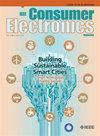物联网无线传感器网络的能量感知避障数据路由方案
IF 10.9
2区 计算机科学
Q1 ENGINEERING, ELECTRICAL & ELECTRONIC
引用次数: 0
摘要
无线传感器网络(wsn)是任何基于物联网(IoT)的消费者应用程序的组成部分。在这样的应用中,移动接收器(MS)通过遍历选定的会合点(rp)来收集感测数据。消费者应用程序生成大量多维数据,并面临各种物理障碍。这些障碍阻碍了传感器节点之间的通信,阻碍了WSNs中MS的移动。这会导致能源消耗增加和数据收集延迟增加。大多数现有的避障数据收集方案存在以下主要局限性:(i)由于MS路径与障碍物之间缺乏安全裕度而导致碰撞风险高;(ii)由于次优RP选择而导致能量消耗不平衡和节点过早失效;(iii)由于未能设计光滑的MS路径而导致急转弯和MS运动效率低下。为了解决这些挑战,本文提出了一种能量感知的物联网wsn避障数据路由方案,该方案使用Manta-ray觅食优化(MRFO)算法来识别最佳rp。在此基础上,提出了基于mrfo的RP选择机制,使传输距离和跳数最小化。平衡传感器节点间的能量负荷,防止节点过早失效。因此,提高了网络的生存期。EBS-A*算法通过避免急转弯来确保MS的平滑运动。EBS-A*算法还保持了障碍物安全余量,降低了MS与障碍物碰撞的风险。仿真和实验结果表明,该方法在剩余能量、网络寿命、稳定周期、数据收集延迟和MS安全评估方面优于现有的最先进方法。本文章由计算机程序翻译,如有差异,请以英文原文为准。
Energy Aware Obstacle Avoidance Data Routing Scheme for IoT Enabled Wireless Sensor Networks
Wireless Sensor Networks (WSNs) are an integral element of any Internet of Things (IoT) based consumer application. In such applications, Mobile Sink (MS) gathers sensed data by traversing through selected Rendezvous Points (RPs). Consumer applications generate a significant amount of multidimensional data and face various physical obstacles. These obstacles prevent communication between sensor nodes and hinder the MS movement in WSNs. This causes increased energy consumption and higher data collection delays. Most of the existing obstacle-avoiding data-gathering schemes suffer from the following major limitations: (i) high collision risks due to lack of a safety margin between MS paths and obstacles, (ii) imbalanced energy consumption and premature node failures due to suboptimal RP selection, and (iii) failure to design smooth MS paths which leads to sharp turns and inefficient MS movement. To address these challenges, this paper proposes an energy-aware obstacle avoidance data routing scheme for IoT-enabled WSNs using MS. It uses a Manta-ray Foraging Optimization (MRFO) algorithm to identify optimal RPs. Furthermore, the EBS-A* algorithm is used to identify a smooth obstacle-avoiding optimal route for MS. The proposed MRFO-based RP selection mechanism minimizes transmission distance and hop count. It balances the energy load among sensor nodes and prevents premature node failure. Therefore, network lifetime is improved. The EBS-A* algorithm ensures smooth MS movement by avoiding sharp turns. The EBS-A* algorithm also maintains a safety margin from obstacles, which reduces the risk of collision between MS and obstacles. The simulation and testbed results show that the proposed approach outperforms existing state-of-the-art approaches in terms of residual energy, network lifetime, stability period, data collection delay, and MS safety assessment.
求助全文
通过发布文献求助,成功后即可免费获取论文全文。
去求助
来源期刊
CiteScore
7.70
自引率
9.30%
发文量
59
审稿时长
3.3 months
期刊介绍:
The main focus for the IEEE Transactions on Consumer Electronics is the engineering and research aspects of the theory, design, construction, manufacture or end use of mass market electronics, systems, software and services for consumers.

 求助内容:
求助内容: 应助结果提醒方式:
应助结果提醒方式:


